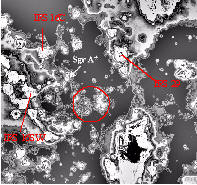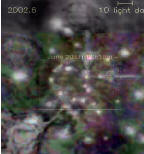Instead of a black-hole there exists a knot structure at the galactic centre
...The Milky Way galaxy is built in the same way as any spiral galaxy. It means hierarchical stacking up of arms on both side forming dual shells, which are arranged in a fractal manner. Each of these fractal arms is made of bifurcated streams, which form one, or multiple mouths, from where ejections occur. The arms constitute fractional dimensional fractal surfaces, which envelop each other like onion shells. The arms appear to rotate in the same direction. This rotation is caused by the vortex motions of the streams. I shall explain it in a later chapter where I shall summarize the dynamics of the structure formation.
The arms rotate and move in a way that all outer shells and the inner shells remain inseparably interlinked. Each shell has two components of motions which manifest through bifurcation of the arms: In one direction the arms feed the smaller shells which lie immediately in their wombs, and on the other direction they move outward to form the outer shell structures. Thus streaming towards the centre go hands in hands with ejections away from the centre throughout the system. The way this mechanism of accretion and ejections works will be discussed later.
Apart from the hierarchy and duality, forming the fractal arrangements of the arms, the galaxy possesses hierarchically embedded spirals in scales after scales, which is typical of any cosmic structure. This, in turn, manifests as the formation of knots in hierarchically descending scales. Thus, whatever I have described as the characteristics of the structure formation in the cosmos, will apply to our own galaxy too.
 ...Often
the most-intense x-ray emission spots are interpreted as the centres of the
galaxies, and the x-ray emission is believed to be caused by the presence of a
black-hole at that spot, which is cannibalizing material from the disk
surrounding the black-hole. In contradiction to this interpretation, the present
analysis shows that the x-ray emissions mostly occur from the spiral arms, which
flank the central structure on opposite sides. The most intense spots are the
ejection mouths that lie in the hierarchically embedded shells. The smaller the
shell structure the more intense is the emission from such mouths. The x-rays
arise from the regions where there exist very hot gases and are often associated
with the regions of intense activities of stellar births.
...Often
the most-intense x-ray emission spots are interpreted as the centres of the
galaxies, and the x-ray emission is believed to be caused by the presence of a
black-hole at that spot, which is cannibalizing material from the disk
surrounding the black-hole. In contradiction to this interpretation, the present
analysis shows that the x-ray emissions mostly occur from the spiral arms, which
flank the central structure on opposite sides. The most intense spots are the
ejection mouths that lie in the hierarchically embedded shells. The smaller the
shell structure the more intense is the emission from such mouths. The x-rays
arise from the regions where there exist very hot gases and are often associated
with the regions of intense activities of stellar births.
In the centre of our galaxy, such x-ray spots are associated with the objects known as Infra-Red Stars (IRS). They are very huge and immensely hot helium stars, or stellar complexes. The most prominent is the IRS 16 complex, which is a source of intense x-ray emission. However, the centre of the galaxy does not lie there. According to the conventional belief the galactic center should lie at the position of the intense radio emission spot called SgrA*.
The intense radio emission spot SgrA*, which is believed to be the centre of our galaxy, may not be the centre. The hierarchical embedding of the dual shell structure continues in the scale of light-days. One can see a double shell structure around a point about 1.5 light month South-East of the SgrA*.In fact, this could be the central structure. This structure is nothing unusual than a dense object that one observes in compact cores where the knot has been disrupted due to extreme tightening. Here one sees more explosive events than what one would expect if a black-hole was devouring the stars from the surrounding.
 ...A
careful analysis of the motions of these stars shows that there is truly no
black-hole at SgrA*. The motions of the stars are governed by the helical paths
along the spiral arms. Like interacting system consisting of many bodies, the
stars in the region seem to exchange material with each other, and the spiral
arms as they move. The changes cause variable emissions from the stars as well
as the arms. The variability depend on the ejections coming from the central
object, which feed the arms fluctuating with time. The variations occur like
pulsations, while the arms fatten by accumulating material from the surrounding,
and then tighten and become thinner. More accumulation of material cause the
conditions of breakdown of knots, which develop in the region. By this mechanism
the material are hurled and transported from the centre to outwards.
...A
careful analysis of the motions of these stars shows that there is truly no
black-hole at SgrA*. The motions of the stars are governed by the helical paths
along the spiral arms. Like interacting system consisting of many bodies, the
stars in the region seem to exchange material with each other, and the spiral
arms as they move. The changes cause variable emissions from the stars as well
as the arms. The variability depend on the ejections coming from the central
object, which feed the arms fluctuating with time. The variations occur like
pulsations, while the arms fatten by accumulating material from the surrounding,
and then tighten and become thinner. More accumulation of material cause the
conditions of breakdown of knots, which develop in the region. By this mechanism
the material are hurled and transported from the centre to outwards.
...As I have said, the stars in the system, moving in the helical paths along
the spiral arms, seem to fatten and shrink, while creating variable
illuminations. The variability of illuminations coincide with episodes of
bursts. While the material streams in, the stars and the arms fatten until
reaching a critical point: After that the stars and the arms shrink by
dispersing material from them. The whole region appears as a pulsating system,
correlated with the ejections coming from the centre.
The occasional flares seen in the immediate vicinity of SgrA*, which are
normally interpreted as caused by the devouring of material from the disk by the
black-hole, could be of different origin: The constant impingement of the arms
from the material hurled from the centre may create scintillation throughout the
spiral arms, which fatten and shrink in unison. The other could be caused by the
cannibalism of the stars by each other. The stars moving in the dense
environment in the region strongly interact with each other as they move, and
they constantly snatch material from the others, when they come nearby.
Read more ....
Copyright ©2006 Anup Rej, All Rights Reserved.